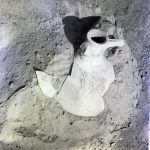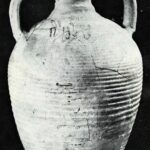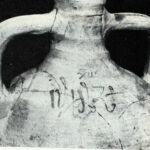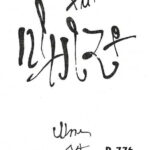| Artefact ID | 1375 |
| TM ID | TM 105026 |
| Findspot (DEChriM ID) | 78 (Kalābša) | Class | Textual |
| Material | Ceramic |
| Writing medium | Dipinto |
| Text content | Subliterary |
| Language | Greek |
| Description | SEG XXXIV 1634: Inscriptions painted in red on an amphora. Reconstructed LRA 1 amphora, initially found in shards, the body of which is egg-shaped with a short broad neck widening slightly, with a small knob on the rounded base, and massive handles roughly attached to the shoulder, with two ribs. Three inscriptions according to ed.pr.: a) immediately below the neck: ΧΜΓ (Christian cryptogram) b) below, on the shoulder, in larger uncial script: ΠΗΖ – presumably the initials of the importer of the wine or oil in the vessel. Long hastas between the letters are probably only meant to draw attention to the abbreviation. The last sign could be interpreted as a Christogram [staurogram]. c) under the left handle, in cursive script, in two short lines, written in retrograde, i.e. to be read from above, from the neck of the vessel: perhaps ἀμήν | ϙθ’ (= 99 = amen – isopsephism). The amphora contained probably wine that was carried from Egypt to Nubia in Syrian amphorae. About Christian symbols on amphoric dipinti, see Fournet & Pietri 2008 and Fournet 2012. |
| Selection criteria | Christian symbols/gestures/isopsephy |
| Date from | 350 |
| Date to | 450 |
| Dating criteria | The amphora is a LRA 1 (Scorpan 8B, Dressel 34 [also with ΧΜΓ formula; CIL XV 4893]). As such, it dates to the end of 4th c. or early in the 5th c. |
| Absolute/relative date | Relative date |
| Archaeological context | Amphora found in tumulus K20/71, in the Kalābša-South cemetery. |
| Accession number | Location unknown. Inv. no. P 776. |


 Json data
Json data







